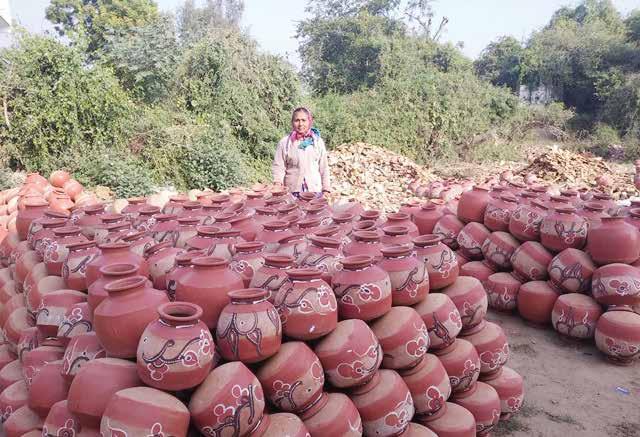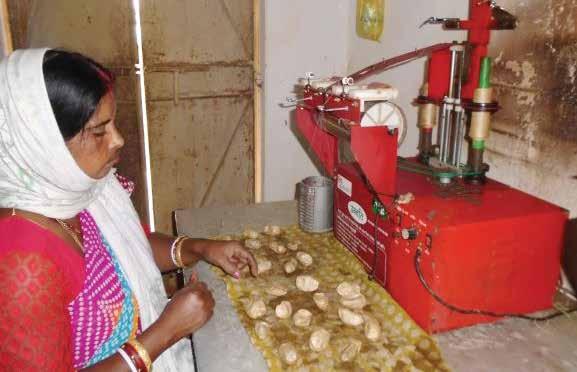
4 minute read
FIGURE 5: Stone idols displayed at a workshop
Solar potential of the cluster
In the Sidlaghatta silk twisting cluster of Chikkaballapura in Karnataka, ~960 microenterprise units are operating. With an installation of 960 units of 4 kWp grid-fed (individual) solar PV system, an aggregated solar potential of 3841 kWp can be realized in the cluster.
Advertisement
4.1.3 Shivarapatna Stone Idolmaking Cluster
Cluster profile
Shivarapatna is a small artisanal village in Kolar district of Karnataka, which is situated around 60 km away from state capital Bengaluru. Patronized by the rulers of the ancient Western Ganga Dynasty, Shivarapatna became home to sculptors from various regions who settled down here, earning the title Shilpakashi (the Kashi of sculptures) of Karnataka. The present-day craftsmen of the village are preserving and carrying forward the 1000-year-old traditional knowledge and skill imparted to them by their ancestors. Today around 1000 people from 200 families are engaged in stone idol making in the village.
Intricately carved idols of gods and goddesses, pillars, and carved stone slabs for temples are the signature creations of the craftsmen of this cluster. The products receive uniform demand throughout the year. The artisans spend almost 25 days a month on a piece. Large and highly intricate pieces often require weeks, months, or even years to be prepared, while smaller pieces can be finished in a few days. The idols are supplied mostly to temples in Karnataka, Kerala, Andhra Pradesh, among others. The Karnataka State Handicrafts Development Corporation
FIGURE 5: Stone idols displayed at a workshop
(Cauvery Handicrafts) supported 20 craftsmen by registering them formally and providing skills training and technology for idol making. Craftsmen can sell their products at government-owned arts and crafts museums.
Production process
The process of idol making starts with choosing the right stone for carving. Then the selected stone is cut to an appropriate size using a band saw. Next, the master craftsman prepares a rough design of the idol on the stone using red oxide paint. The extra edges of the slab are removed using a hammer or cutter machine. The craftsmen chisel out the design on the stone slab and smoothens the surface using an electric grinder machine. Further, buffing of the idol is done to remove dust particles. Finally, the finished idol is polished and ready to be dispatched.
Energy consumption
The stone idol making includes equipment such as band saw, cutting machine, grinder, blower, buffing, and polishing. These machines with cumulative capacity of 5 HP are run for 8–10 hours a day. Most of the processes are carried out simultaneously. Low tension (LT) domestic connections are used for such power requirements. The average income of the units varies from INR 50,000 to INR 80,000 per month. The average monthly electricity bill of the stone unit is around INR 5000. Power subsidy is not available due to lack of commercial connection. Like other clusters, entrepreneurs in this cluster are also willing to explore the option of solar PV to power their production activities and contribute to 20–30% of the system cost from their end.
Design of solar PV
TERI proposes grid-fed individual 5 kWp solar PV system (without battery back-up) for each and every stone idol unit. The design of the system has been done considering the space constraint and investment capacity of the studied cluster. Thus, it has been assumed that 50% of the energy will be met through solar and the balance 50% will be met through the grid.
The area requirement for solar installation is around 40 m2. To introduce solar PV in the cluster, the investment would be around INR 270,000 for each idol unit [based on benchmark price (INR 54 per Wp) of grid-tied solar PV system notified by MNRE, Government of India].
Proposed business model
In this cluster, without subsidy component, and with an upfront investment of 20% of the hardware cost and loan component of 80% of the overall hardware cost, payback is estimated to be more than 15 years. However, with 20% upfront equity investment from a micro-enterprise owner, a 5-year bank loan for 20% of the capital investment and a subsidy of 60% cost of the solar PV system, payback period comes down to 5.33 years and 5 years when the bank interest rate is 12% and 8% per annum, respectively.
The Karnataka State Handicrafts Development Corporation (Cauvery Handicrafts), which has been set up to preserve and develop the traditional handicrafts of the state, can be approached for the maximum subsidy of 40–50%. Besides, DIC can be approached for partial capital subsidy (10%) as per the industrial policy.4 Also, the popular PMMY scheme can be explored for availing Mudra loan. It is also important to note that without subsidy and with an upfront equity investment of 20% and loan component of 80%, the payback period is estimated to be more than 10 years. Hence, it is likely that to advance the designed solar system in the cluster, a mix of subsidy, upfront investment, and bank loan will have to be explored.
4 Details available at https://kum.karnataka.gov.in/KUM/PDFS/Operative%20Guidelines%20for%20DIC%20KARNATAKA%20
INDUSTRIAL%20POLICY%202014-19.pdf




